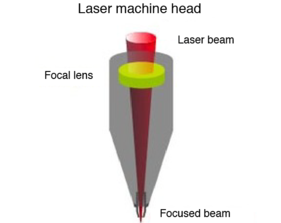Cutting is a manufacturing process used to separate materials. Laser cutting is often used in industrial manufacturing areas for cutting sheet metal and piping. It uses a computer controlled high output laser to do the cutting. Plasma cutting uses a torch which blows an inert gas at high speed through a nozzle which when held close enough to the parts creates an arc and melts the material. Water jet cutting uses extremely high pressure and velocity water to cut into metals. A torch is used in oxyfuel cutting to heat the metal; oxygen is then blown into the part causing the metal that it combines itself with to leave the cut as slag. Electric discharge (EDM) is also known as spark machining or spark eroding. EDM removes material by rapid arc discharges between the electrode of the cutter and the work-piece which has to be a conductor.
Today we are talking Laser cutting which is one of many laser processes that have noticed a much more widespread use over recent years. Many of the laser processes have similar benefits and applications, and as one laser machine can perform multiple processes, it can be hard knowing exactly which one could be right for your business.
 What is laser cutting?
What is laser cutting?
Laser cutting, as the name may suggest, is the process of cutting a material using a laser beam. This can be done to either trim down a material or to help cut it into complex shapes that more conventional drills would struggle with.
This laser process also has many similarities to the laser drilling and laser engraving processes. The former involves the creation of thru-holes in a material or dents, like an engraving used in the later process. These dents and holes are essentially cuts, and you’ll often see a laser cutting machine being used for laser drilling and laser engraving too.
A vast range of materials and thickness sizes can be cut using laser cutting, making it a handy and adaptable process.
How it works
The laser cutting process works by having a focused and precise laser beam run through the material, delivering an accurate and smooth finish. Initially, the laser is used to pierce the material with a hole at the edge, and then the beam is continued along from there.


The laser being used essentially melts the material away that it is run over, so is more like melting than cutting. This means that it can easily cut light materials such as cloth up to tougher metals and gemstones such as diamonds.
What’s the advantages of laser cutting compare to CNC machining?
- Laser cutting has low maintenance costs and only needs inexpensive replacement parts
- The laser cutting process helps to dramatically reduce material wastage
- One laser cutting setup is capable of working with multiple materials.
- It is much safer using laser cutting than other processes as the beam is enclosed within a light box
Due to it’s low cost and high efficiency, laser cutting is a widely used for rapid prototyping and low volume manufacturing, or even large quantity production. If you have some sheet metal parts to need do, welcome to contact Danke Mold!
